140 Search Results for schedules
January 2, 2018
by Carole Zangari -

The new year brings hope and promise, something that the AAC community can always use a little more of. Here are some thoughts on strengthening our sustainability as AAC service providers as we embark on the upcoming year. View our role in AAC as a marathon, not a sprint. Supporting AAC learners can be an overwhelming experience and requires staying power. Pace yourselves, AAC friends. We have to be in it for the long haul, and that means we can’t use up all of our energy in the first leg of the journey. It’s okay to go home even though there’s more left to do. Remember the flight attendant’s advice: Put on your own oxygen mask before helping others. Keep learning. No matter how much you know about AAC, there is always more to learn. Whether it is reading journal articles to keep up with the latest research, viewing videos... [Read More...]
August 10, 2017
by Carole Zangari -
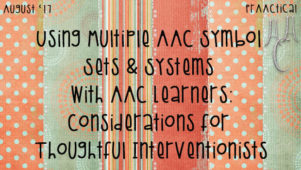
PCS, Pixons, Minspeak symbols, Smarty Symbols, Symbol Stix, CoughDrop Symbols, ARASAAC symbols, Mulberry symbols, Lesson Pix, Sclera symbols, and more. In terms of AAC symbol options, we are living in plentiful times. It isn’t uncommon to see situations like Jonah’s. On a typical school day, Jonah is likely to encounter at least three types of pictures for the same words. He has Smarty Symbols on his AAC app and a classroom core board with PCS, and is using instructional materials using Symbol Stix. These are each great ways of visually representing language, but here’s something to think about: Does it help or hurt Jonah to have 3 different pictures for the same word? There are many options in symbol sets and systems, and each has its own strengths and weaknesses. Here are some things to think about as you and your team are making these decisions. There is no empirical... [Read More...]
May 18, 2017
by Carole Zangari -
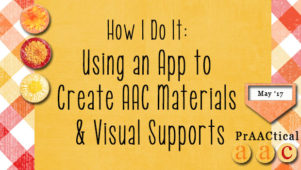
When we think of AAC apps, expressive communication and voice output generally come to mind. But there are other kinds of AAC apps, too, including those that are used to create printable materials. Today, we hear from a clinician who uses this kind of AAC app on a regular basis. Georgia Karavias is a speech language pathologist whose career has centered around working with school-aged children and adolescents who have physical disabilities and communication difficulties. Georgia is passionate about utilizing alternative access methods and inclusive technologies to enable independent communication using AAC systems. She currently works at Scope’s Communication and Inclusion Resource Centre (CIRC) as part of the communication access team in a community capacity building role. In this post, she talks about how she uses AAC and visual supports created with an app developed at her workplace. :::::::::::::::::::::::::::::::::::::::::::::::::::::::::::::::::::::::::::::::::::::::::::::::::::::::: I am a speech pathologist who has worked with children with complex... [Read More...]
March 9, 2017
by Carole Zangari -
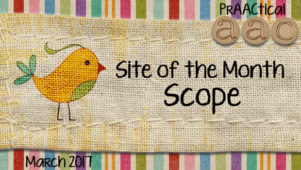
Looking for information of use to service providers, people who use AAC, and their families? Our March Site of the Month features a website that fits the bill. Scope, an Australian disability service agency, has information and downloadable resources that you may want to explore. Here are some of the highlights. CIRCus Blog The agency supports a blog with content from Scope’s Communication and Inclusion Resource Centre and includes several topics related to AAC. Eye gaze: For people with significant motor difficulties, eye pointing or eye gaze may play an important role in their access to communication. Having communication partners who know how to maximize the success of this strategy can make the difference between incredible success and perpetual struggle. In this post, they walk us through the process of supporting people who use eye gaze. Schedules: Therapists and teachers regularly use visual schedules to help people with AAC needs... [Read More...]
February 8, 2017
by Carole Zangari -
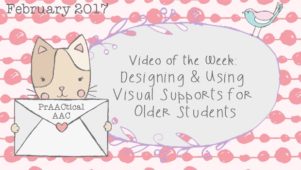
Chances are, you are already using visual supports with your AAC learners. If they aren’t as effective as you imagined they would be, or if you need ideas for how to make them more appropriate for middle and high school students, this video is worth watching. Karine Gleason helps us learn more about making age respectful visual boundaries, cues, and schedules, and gives us tips for fine-tuning our implementation. Many thanks to TASN and the Tri-State Autism Spectrum Disorder Network for making and sharing this video.
December 25, 2016
by Carole Zangari -
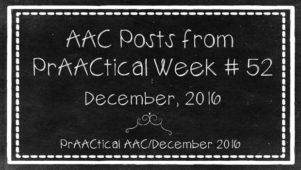
Hoping you are enjoying the holiday season with friends and family. Here are some posts that may be of interest. Monday: Selecting AAC Apps & Devices: A Handful of Reasons Not to Skip the Trial Period Wednesday: Video of the Week: Implementing Object-based Schedules in the Classroom Thursday: AAC Apps and Devices: Thoughts on Conducting AAC Trials Friday: An AAC Christmas Carol
December 5, 2016
by Carole Zangari -
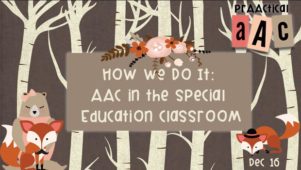
At the ASHA Convention last month, I chatted with an SLP about her secret longing: To take a sabbatical and travel the world to see AAC in action. Wouldn’t that be exciting?! In the meantime, we’ll have to live vicariously and peek into AAC practices through the words and pictures of dedicated professionals. Angi Pearce, a teacher at Kowhai Special School in Hastings, New Zealand, was kind enough to help us out and share her experiences in increasing AAC use in her classroom. Angi is the team leader for the Junior School classes (ages 5-11) and graciously prepared this post with support from SLP Michelle Roberts. As you’ll see, Angi is a highly experienced educator but new to the world of AAC and not afraid to take risks and embrace change. Let’s take a look at how a veteran teacher stretched herself to incorporate more AAC into her classroom. :::::::::::::::::::::::::::::::::::::::::::::::::::::::::::::::::::: AAC IN THE CLASSROOM My... [Read More...]
November 7, 2016
by Carole Zangari -
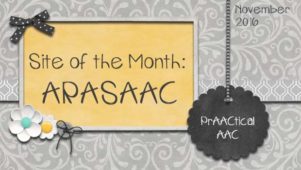
Symbols, templates, software, tools, and more. That’s what you’ll find on the November PrAACtical Site of the Month: ARASAAC, the Aragonese Portal of Augmentative and Alternative Communication. Supported by the Department of Education, Culture and Sports of the Aragonese Government and the General Directorate of Innovation, Equality and Participation, this award-winning site has been serving the AAC community for over two decades. They may be best known for the picture symbols that they share so freely, which allows professionals, users of AAC, and families to create free resources in Catalan, Euskera, English, French, German, Italian, Galician, Portuguese, Spanish, and more. The online tools section has a variety of things to explore including tools to make communication boards, animations (gifs), schedules and calendars, custom symbols, and games. There are also wonderful resources for Spanish Sign Language in pictures and videos. There is also a Materials Exchange section where you can download communication... [Read More...]
September 1, 2016
by Carole Zangari -
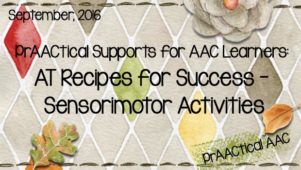
It’s time to resume our PrAACtical Supports series, highlighting handout materials developed by Sara Barnhill and the AT team at the Children’s Hospital of Richmond at VCU (CHoR). Sara is an SLP who has has worked at CHoR for six+ years. She is a member of the Assistive Technology Core team and VCU’s Center for Craniofacial Care team. Her caseload includes patients in clinics, outpatient therapy, and on the Transitional Care Unit which provides pediatric long-term care. The CHoR AT Program is one of few comprehensive AT programs in Central Virginia, providing AT evaluations, equipment and training to people of all ages, enabling children and adults with disabilities to function more independently. CHoR’s AT team consists of 4 SLPs, 2 OTs, a PT, and a Therapy Practice Assistant. In addition to completing transdiciplinary evaluations and treatments, CHoR’s AT team is responsible for supporting staff and sharing AT information to five CHoR therapy centers... [Read More...]
June 29, 2016
by Carole Zangari -
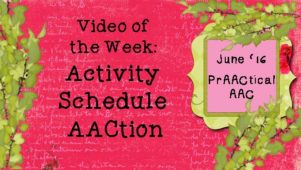
Over the years, we’ve written quite a bit on the prAACtical powers of visual schedules. Activity schedules, known also as mini schedules or task schedules, are great ways to help AAC learners understand what will be happening in a particular activity. Understanding what events will take place helps us all better prepare ourselves for active and appropriate participation in those events. In today’s post, we feature a number of short videos with information on and examples of this strategy. Thanks to the Watson Institute for creating and sharing these videos. Going to the Doctor’s Office Going to the Library Going to Physical Education (PE) Class Going to a Fast Food Restaurant Getting Ready for Bed









